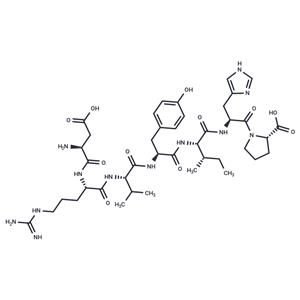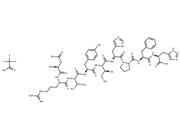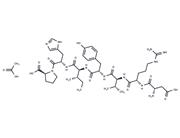| Name | Angiotensin (1-7) |
| Description | Angiotensin (1-7) (ASP-ARG-VAL-TYR-ILE-HIS-PRO) is a synthetic heptapeptide identical to endogenous angiotensin-(1-7) , inhibits purified canine ACE activity (IC50=0.65 μM) with vasodilator and antiproliferative activities. |
| Cell Research | Cultured cardiomyocytes were treated with PBS (control), ANG II (100 nM), ANG-(1–7) (100 nM), ANG II + ANG-(1–7), ANG II + ANG-(1–7) + A779 (10 μM), ANG II + ANG-(1–7) + Sirt3 short hairpin (sh)RNA, lentiviral particles (1 × 10^6 TU) containing a Sirt3 shRNA viral vector, or ANG II + Mito-TEMPO (0.1 μM) for 24 h. Each treatment was performed in triplicate wells. Monoclonal anti-α-sarcomeric actin antibody was used for identification and measurement of cardiomyocytes via immunofluorescence staining. Cells were fixed in methanol at ?10°C and washed with fresh washing solution (0.1% Triton X-100 in PBS) three times. After preincubation with 3% BSA for 20 min, cells were incubated with primary antibody, which was diluted to 1:100 with PBS containing 3% BSA, overnight at 4°C. After three washings with the washing solution, cells were incubated with fluorescence-conjugated anti-mouse IgG (1:500 diluted in PBS) for 1 h at room temperature. Photographic images of cardiomyocytes were taken with a fluorescence microscope. Image-analysis software was used to measure the cell surface area of cardiomyocytes that were positively stained for sarcomeric actin. Variations in cell size were expressed as relative cell surface area versus the control. At least 50 cells in each dish were randomly selected for surface area analysis[1]. |
| Animal Research | Eighteen dogs were randomly assigned to sham group, pacing group and Ang-(1-7) group. Rapid atrial pacing was maintained for 14 days in the pacing and Ang-(1-7) groups. Ang-(1-7) was administered intravenously in the Ang-(1-7) group. The atrial effective refractory period and atrial fibrillation inducibility level were measured at baseline and under sympathetic nerve stimulation after 14 days of measurement. The atrial sympathetic nerves labeled with tyrosine hydroxylase were detected using immunohistochemistry and Western blotting, and tyrosine hydroxylase and nerve growth factor mRNA levels were measured by reverse transcription polymerase chain reaction[2]. |
| In vitro | ANG-(1-7) significantly attenuated ANG II-induced cardiac hypertrophy and perivascular fibrosis in these rats. These effects of ANG-(1-7) were confirmed in cultured cardiomyocytes, in which ANG-(1-7) significantly attenuated ANG II-induced increases in cell size[1]. |
| In vivo | Ang-(1-7) treatment attenuated the shortening of the atrial effective refractory period and the increase in the atrial fibrillation inducibility level. Immunohistochemistry and Western blotting showed sympathetic nerve hyperinnervation in the pacing group, while Ang-(1-7) attenuated sympathetic nerve proliferation. Ang-(1-7) alleviated the pacing-induced increases in tyrosine hydroxylase and nerve growth factor mRNA expression levels[2]. |
| Storage | keep away from moisture | Powder: -20°C for 3 years | In solvent: -80°C for 1 year | Shipping with blue ice. |
| Solubility Information | H2O : 8.99 mg/ml (10 mM)
|
| Keywords | Endogenous Metabolite | Angiotensin Receptor | Angiotensin (17) | Ang | Inhibitor | Angiotensin (1-7) | inhibit | Angiotensin | Angiotensin (1 7) | Angiotensin-converting Enzyme (ACE) |
| Inhibitors Related | Sucrose | Daidzein | Guanidine hydrochloride | Fumaric acid | Ferulic Acid | Formamide | Oleamide | Glycerol | Thymidine | Naringin |
| Related Compound Libraries | 经典已知活性库 | 膜蛋白靶向化合物库 | ReFRAME 相关化合物库 | 多肽分子库 | 抑制剂库 | NO PAINS 化合物库 | 抗衰老化合物库 | 已知活性化合物库 | 抗COVID-19化合物库 | 人代谢物化合物库 |

 United States
United States



